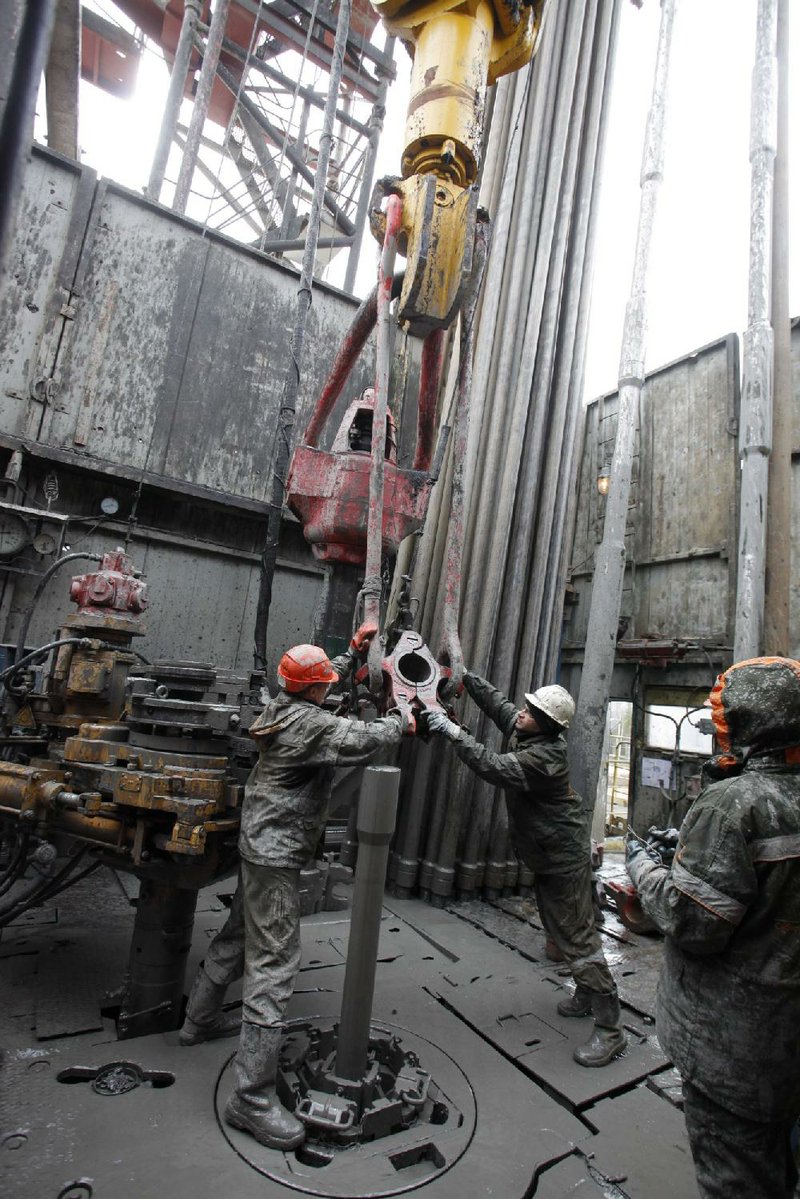Russia’s thirst for modern rigs able to drill in shale oil deposits is a potential $9 billion bonanza for manufacturers including National Oilwell Varco Inc. of the U.S. and China’s Honghua Group, oil field analysts say.
More than 57 percent of Russia’s 1,835-strong rig fleet is over 20 years old, according to VTB Capital research. Built to Soviet designs, many won’t be powerful or advanced enough for producers such as OAO Rosneft and OAO Gazprom Neft when they begin exploring Siberia’s shale rock, said Antony Crawford, Russia head for National Oilwell. The largest U.S. oil equipment supplier competes with Honghua and OAO OMZ for orders in Russia, the world’s largest energy producer.
“Russia’s rig fleet is too old, too light and it lacks agility,” said Olga Danilenko, an oil-field services analyst at Russian investment bank VTB Capital. Paying to move an old rig in a remote region is a big risk considering the likelihood of a breakdown and expensive logistics in providing parts, she said.
Rosneft and partner Exxon Mobil Corp. started exploring the Bazhenov shale this year, a Siberian formation as big as France that state geologists estimate contains enough oil to more than double Russia’s reserves. President Vladimir Putin wants it developed to help maintain production above 10 million barrels a day. Compared with conventional oil, shale needs more rigs. The machines also must be more powerful, driving unit costs to the middle of a $10 million-$60 million price range.
“New drilling rigs must be built,” said Crawford, whose Houston-based company plans a factory east of Moscow. “This issue represents a clear and present danger to Russia’s ability to maintain output during the next three to five years.”
Deliveries of new rigs will reach a five-year high of 105 units this year, according to VTB data. Still, older rigs are being retired at a rate of more than 400 a year, threatening a squeeze on capacity as drilling ramps up.
National Oilwell, which had $20 billion in revenue last year, may sell five rigs to Russia-focused companies this year, VTB said. It will compete with Russia’s OAO OMZ, owner of the Uralmash plant, a Soviet tank factory in World War II that became one of the world’s biggest rig builders during the oil boom of the 1970s. While production collapsed after the end of communism, it remains an important supplier.
Honghua Group, China’s largest exporter of drilling rigs, sees a need for more of its gear in Russia, Zhang Mi, chairman and president, said earlier this month in an interview. The company’s second largest sales region is Russia, he said.
“Half the drilling rigs there are outdated,” Mi said through a translator at the Offshore Technology Conference in Houston. “They see a great need for new innovative equipment.”
The company has started a joint venture in Russia to meet demand, he said.
“Part of the production equipment is coming from China and part from Russia,” he said. “Together we are able to meet the demand in Russia.”
Last year Russia’s monthly count of rigs in operation ranged from a low of 717 rigs in February to a high of 978 rigs in June, according to data on REnergyCo’s website.
A lack of rig capacity hasn’t yet dented Russian output, which hovered near a post-Soviet record at 10.47 million barrels a day in March, and it may be early to talk about a drilling rig shortage, said Ildar Davletshin, an oil and gas analyst at Renaissance Capital.
“The talk about shortage has been ongoing for many years, but so far it has not materialized,” he said. “There is tighter balance for high-spec rigs that will be potentially in higher demand” as shale fields are developed.
Chinese, U.S. and German manufacturers seem capable of delivering required quantities of rigs, he said.
Rosneft and Gazprom Neft have paired with Royal Dutch Shell Plc, seeking to follow strategies used in the U.S., where blasting oil from rock in places like the Bakken shale in North Dakota reversed decades of production declines.
Because oil can be harder to extract from shale, rigs often need to turn a drill bit 90 degrees and continue penetrating horizontally. This is combined with a process called fracturing where water, sand and chemicals are pumped into a well to smash rock and increase oil flows.
A lack of modern rigs remains a key stumbling block to developing Bazhenov, Bernstein Research analysts including Oswald Clint wrote in a note Tuesday.
Rosneft and Gazprom Neft didn’t respond to requests for comment on Russia’s oil rig fleet.
In the U.S., 250 rigs are needed to produce about 700,000 barrels a day at the Bakken shale, said Richard Anderson, chief financial officer of Eurasia Drilling Co., Russia’s largest rig operator. That gives an indication of how many rigs could be needed to exploit the Bazhenov, he said.
Supplying that number of rigs at an average of $35 million each would cost $8.8 billion.
“These rigs are not currently in the Russian drilling fleet, so they would need to be added,” Anderson said.
Business, Pages 25 on 05/30/2013

